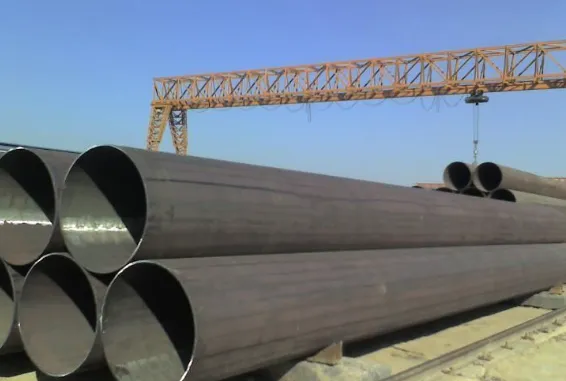With the development of world science and technology, there are an increasing number of various engineering projects. Piling pipes have been further promoted and applied due to their simple construction technology, good cost performance, high-quality performance and strength.It is a pipe made of welded steel pipe , its reference standard is ASTM A252.In order to effectively improve the construction quality of projects , production efficiency, we must pay more attention to the control of the construction process. Nowadays, the relatively mature construction technology of prestressed pipe piles includes static pressure method, hammering method or pre-drilled pile insertion. However, with the increase in construction projects, piling pipes have also encountered many problems during the construction process. The following will introduce some common problems and solutions during the construction of piling pipes.

Problems in piling pipe construction
1. The pile body is displaced
Pile top displacement and pile body inclination are two forms of pile body displacement. The bearing capacity of a single pile is greatly affected by the tilt of the pile body, especially the horizontal bearing capacity. The pile top displacement will add an additional bending moment based on the load transmitted by the vertical components of the superstructure (columns, shear walls, etc.), which is very detrimental to the pile's bearing capacity. During construction, the pile body failed to be vertical, the pile body and pile caps were not kept in the same straight line, and the improper construction sequence resulted in the failure to evenly spread the stress, especially the caps that were too dense or too close to the deep foundation pit in the adjacent basement. , causing holes to appear on one side of the front construction, and the pile body can easily slide during subsequent construction on the other side. When the pre-drilling method is adopted, excessive vertical deviation of the borehole is produced, and the offset direction is inclined along the borehole during sinking. conduct.
2. The top of the pipe pile is broken
During the construction of prestressed pipe piles, if the top part of the pile structure cracks, it is mainly due to the selection of construction tools with mismatched specifications and power, or the design drop distance of the pile hammer is too large, causing the prestressed pipe pile to break. The concrete structure at the top of the pipe pile suffered impacts beyond the design requirements. When the driving force exceeded the material strength, it broke and cracked.
3. Exposed piles and short piles
Due to the fluctuations in the bearing layer, the pile length was not adjusted in time in the design. When the pile was inserted into the bearing layer to a certain depth (usually 2 meters), it could not be driven in and was terminated, causing the pile body to expose too much of the designed pile top (usually 1-2 meters). meters, up to 5-6 meters) to form exposed piles. Similarly, due to the undulating changes in the bearing layer, short piles are formed when piles are driven to the design elevation but have not yet entered the bearing layer or the penetration is still very large and they still need to continue sinking.
4.Pile body fracture phenomenon
During the pile pressing process, if the cantilever body is suddenly tilted and misaligned, and there is no special change in the soil quality at the pile tip, the penetration suddenly increases, the oil pressure gauge of the yield cylinder shows a sudden drop, and the machine starts to move. Quality problems such as pile body breakage may occur.
Prevention and treatment methods
1. Find out the reason. First, start by analyzing the survey data, and supplement the survey where the fluctuations of the bearing layer change greatly. Drilling holes should be arranged at important pillar locations to determine the depth and nature of the bearing layer. For important buildings, the survey unit should submit a "contour map of the bearing layer" or a "contour map of the bearing layer".
2. During on-site pile testing, determine the criteria for terminating pile driving based on the pile testing conditions. Under normal circumstances, "dual control" is implemented to control both length and penetration. For friction end-bearing piles, penetration should be the main factor and pile length should be the secondary factor. For impact pile drivers, the penetration is greatly affected by the weight of the hammer and the piling machinery, so attention should be paid to it. The static pressure pile driver can be controlled by the reading of the hydraulic gauge on the pile driver. According to the author's experience, the process can be terminated when the final pressure displayed on the hydraulic gauge reaches 2.0-2.5 times the design single pile bearing capacity.
3. Replenishment combined with technology. When driven piles are connected in sections and sunk one by one, the connection nodes may become disconnected. In this case, the method of combining supply and repair can be used.
4. Pile patching technology. For the construction of prestressed pipe piles with a small designed pile spacing, holes can be opened first through mechanical operations of on-site personnel, then piles can be planted, and finally pile sinking can be carried out using conventional technical methods.
5. Modify the pile type or pile sinking parameters. This treatment technology can be implemented from many aspects, including: changing the pile position, changing the pile type, changing the pile sinking equipment, and changing the soil depth.
While prestressed pipe piles are widely used based on their unique advantages, their shortcomings also need to be noted. We should constantly improve and improve in design and construction, strictly carry out production operations in accordance with relevant standards and specifications, and rationally select construction and processing technologies to avoid the occurrence of quality problems, so as to better adapt to the development and development of the construction industry. need.






 English
English Español
Español بالعربية
بالعربية











 Phone :
Phone :  Whatsapp :
Whatsapp :  Email :
Email : 


